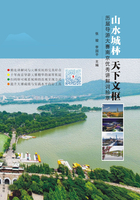
Yuejiang Tower Scenic Area

赛项:2014年第四届南京市导游大赛
选手:季映雪(三等奖)
选送:秦淮区旅游局
Ladies and gentlemen, good morning!
Now, we are on the way to Yuejiang Tower Scenic Area, which is located in the northwest of Nanjing.
Yuejiang Tower is standing on the top of Lion Mountain, near the bank of the Yangtze River . It is one of the 10 famous cultural towers in China.
On the left, that is the marvelous and splendid Yuejiang Tower. 600 years ago, ZhuYuanzhang defeated his strong rival ChenYouliang , which set up the basis for the reign of Ming Dynasty and for taking Nanjing as the capital. Therefore, he planned to build a tower to memorize it. He named the tower as Yuejiang and ordered every civil minister to write an article named Record of Yuejiang Tower, but, this construction plan was cancelled due to several reasons. Till 2001, after 600 years of no tower but having records, Yuejiang Tower was eventually finished and opened up to the public, which became the fourth famous tower in China, following Huanghe, Yueyang and Tengwang Tower.
On the way to Yuejiang Tower, we can learn more about Nanjing's history as well as its cultural connotation along the Yangtze River.
Now we are passing the earliest railway station called Nanjing West Railway Station which is located on the bank of Yangtze River. It was first constructed in 1909 and was rebuilt as Nanjing Xiaguan Railway Station by Kuomintang government in 1930. After the liberation in 1949, the station was under reconstruction and named as Nanjing West Station which is still in use. The station had once become the flourishing transportation center in East China.

南京西站
In front of us is Grand Heaven and Earth Mall, which is located in the commercial center of former Xiaguan District. It is one of the key trading programs of Nanjing 11th Five-year Project. With the great promotion of the project named Yangtze River Time, the Grant Heaven and Earth Mall is taking its task to further historical heritage and to import the most advanced commercial activities, so as to build a five-star entertainment and shopping center for citizens in Nanjing.
Dear guests, this road is called Zheng He Road. Zheng He was the great navigator who started the voyage to western oceans from the moat of Jinghai Temple in 15th century.
On the left side of the road, there is Nanjing Jinghai Temple, It was given the name of Jinghai by the emperor Zhudi, meaning all seas were calm. On August 29,1842, the Nanjing Treaty was signed, which was the first unequal treaty in the modern history of China.
On the east side of Jinghai Temple, you can see Tianfei Palace. It was built in the 5th year of Yongle period in the Ming Dynasty, which was 1470, when Zheng He came back after the first voyage. In order to appreciate the safety on the sea on the mercy of the goddess Mazu, which is called Tianfei in Chinese, Emperor Zhu Di gave the approval to build Tianfei Palace.
Later, it became a popular tradition to visit Tianfei Palace for worship and outing activities around Mazu's birthday each year.
Ladies and gentlemen, now, in front of us is Yifeng Gate, which is one of the 13 city gates built in the Ming Dynasty. In the Ming and Qing Dynasties, this gate was the main channel to the Yangtze River of Xiaguan area, which played an important strategic role in the period of Taiping Heavenly Kingdom, the Republic of China and Anti-Japanese War.
Dear guests, Yuejiang Tower is here. Please follow me and enjoy more interesting stories and marvelous sceneries.
Thank you for listening.
关键词点击
长江

南京长江大桥
长江发源于“世界屋脊”——青藏高原的唐古拉山脉各拉丹冬峰西南侧。干流流经青海、西藏、四川、云南、重庆、湖北、湖南、江西、安徽、江苏、上海11个省、自治区、直辖市,于崇明岛以东注入东海,全长约6300千米,比黄河(5464千米)长800余公里,在世界大河中长度仅次于非洲的尼罗河和南美洲的亚马逊河,居世界第三位。但尼罗河流域跨非洲9国,亚马逊河流域跨南美洲7国,长江则为中国所独有。
长江干流自西而东横贯中国中部。数百条支流辐辏南北,延伸至贵州、甘肃、陕西、河南、广西、广东、浙江、福建8个省、自治区的部分地区。流域面积达180万平方公里,约占中国陆地总面积的20%。淮河大部分水量也通过大运河汇入长江。
长江干流宜昌以上为上游,长4504公里,流域面积100万平方公里,其中直门达至宜宾称金沙江,长3464公里。宜宾至宜昌河段习称川江,长1040公里。宜昌至湖口为中游,长955公里,流域面积68万平方公里。湖口至出海口为下游,长938公里,流域面积12万平方公里。
知识拓展
下关火车站
南京下关车站位于下关区龙江路8号。1908年沪宁铁路建成通车后,称为沪宁铁路南京车站;国民政府定都南京后,改称南京下关车站;汪伪时期,一度称为南京车站;1968年底,位于玄武湖北侧的南京火车站建成后,定名为南京站;下关火车站因相对位置处于西部,所以更名为南京西站。
下关车站初建于清光绪三十一年(1905年)。1930年,国民政府铁道部对车站进行重建。1947年,国民政府对下关火车站进行扩建。扩建工程由基泰工程司杨廷宝建筑师设计,徐顺兴营造厂建造,当年完工。1948年,又增建站台1座。1949年,国民党军队撤退时,车站中央大厅遭到毁坏。中华人民共和国建立后,南京市人民政府重新修造,建成了1800平方米的候车厅。南京下关火车站作为民国时期南京的重要门户,在当时发挥了巨大的作用。
1912年元月1日,孙中山由上海到南京就任中华民国临时大总统,便是经过下关火车站进入南京城的。
1946年的“下关惨案”就发生在下关火车站内。当年5月5日,国民政府还都南京。此后,蒋介石集团以南京为中心,策动反共内战。1946年6月23日,上海市各界群众10余万人举行反内战、要和平的群众大会,推选出以马叙伦、胡厥文、阎宝航、雷洁琼等11人为代表的上海人民和平请愿团,前来南京向国民政府请愿。当请愿团于当晚到达下关火车站时,担任津浦铁路调查统计室主任的中统特务头子陈叔平,纠集一批暴徒,伪装成苏北难民,把请愿代表围困在候车室和西餐厅,大喊大叫乃至大打出手,殴伤包括代表团团长马叙伦在内的代表团成员多人。前往欢迎代表团的民盟代表叶笃义、现场采访的《大公报》记者高集、《新民报》记者浦熙修也遭毒打。暴徒们行凶闹事5个多小时。这就是骇人听闻的“下关惨案”。